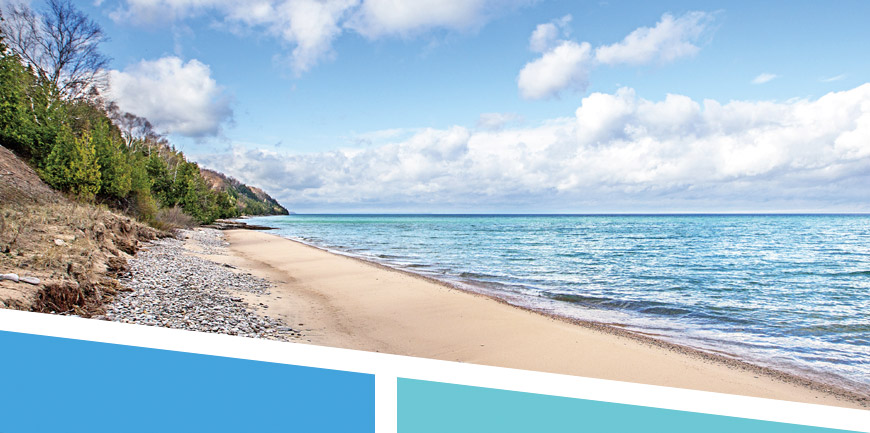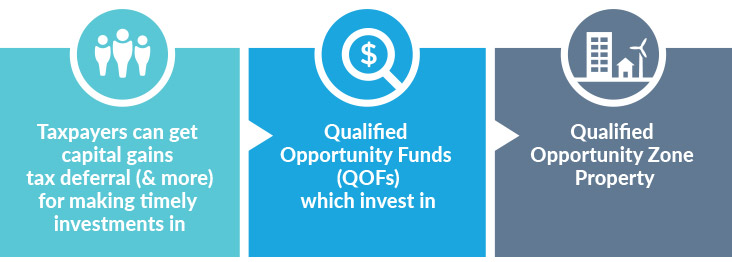
ATTRACTING CAPITAL INVESTMENT TO WHERE MICHIGAN NEEDS IT MOST.
The concept of Opportunity Zones was created in the 2017 U.S. Tax Cuts and Jobs Act. Opportunity Zones are designed to increase the amount of patient (long-term) capital investments in low-income communities around the country that have been cut off from capital and have experienced a lack of business growth. There are three types of tax incentives that relate to the treatment of capital gains. Each incentive is tied to the longevity of an investor’s stake in a qualified Opportunity Fund. The greatest incentives are reserved for investments held for 10 years or more.

Opportunity Zones throughout the U.S.
- In the U.S., there is $6.1 trillion in unrealized capital gains each year.
- There are 8,761 qualified Opportunity Zones census tracts across all states, territories, D.C.
- The average poverty rate in these census tracts is 31%, well above the 20% eligibility threshold.
- The average median family income in these census tracts is 59% of its area median (compared to the 80% eligibility threshold.)
- Opportunity Zones are 38.2% urban, 39.6% rural, and 22.2% suburban.
Opportunity Zones in Michigan
- There are 288 Opportunity Zones census tracts in Michigan
- 888,822* living in Michigan Opportunity Zones
- 65 of the census tracts are rural (23% vs. 39.6% in the U.S.)
- The average poverty rate is 32.1% (vs. the U.S. 31%)
- The average median family income is in the 60.3% percentile (vs. the U.S. 59%)
- The average unemployment rate – 16.6% (vs. U.S. 14.4%)
(* Estimated population living in Michigan Opportunity Zones, based upon the 2017 American Community Survey five-year estimate. The total state population is recorded at approximately 9,925,568.)
How Opportunity Zone designations were made
The designation of Opportunity Zones was a two-step process.
Step 1
The first step determined the geographic distribution of the state’s 288 Opportunity Zone designations using an area’s proportional share of the statewide total of eligible low-income tracts (1,158). If a county had 25% of the state’s eligible tracts, it was initially given 25% of the state’s eligible tract designations. Then, designation considerations and any necessary modifications were made to account for original Rising Tide communities and each rural county that had at least one low income census tract.
Step 2
A set of data driven economic indicators were then used to determine the initial set of Opportunity Zones around the state. Both Congress and the Economic Innovation Group guided policymakers charged with creating these zones. According to these guidelines, Opportunity Zones should:
- be the targets of already-existing community development programs at all levels of government;
- demonstrate success in receiving investments from other geographically-targeted programs;
- be named in areas of sudden employment losses (plant closings or mass layoffs);
- take into account area attributes that will attract the attention of capital, such as habitability for prospective entrepreneurs and good linkages to population centers and anchor institutions such as hospitals or colleges/universities;
- be able to attract a number of different types of investments, since the classes of qualified activities range from investment in local Opportunity Zones companies to real estate transactions—both residential and commercial.
To make the designations, the following geographic attributes were chosen because they align with these guidelines:
- Qualified Census Tract (QCT) designations: Projects located in these areas receive incentives under the Low Income Housing Tax Credit program.
- Michigan State Housing Development Authority (MSHDA) / Michigan Economic Development Corporation (MEDC) investments: Tracts with these investments have proven their ability to attract development activity in commercial and real estate transactions.
- Worker Adjustment and Retraining Notification (WARN) locations: These show where plant closings or mass layoffs have been announced over the last two years.
- Dun and Bradstreet business listings: These are used to delineate different types of business activity, including manufacturing concentrations (automotive, agricultural, and other industrial activity, retail and commercial centers, and other such nodes).
- Redevelopment Ready Communities and Rising Tide communities: Tracts within municipalities with these MEDC designations are acquiring the capacity to manage larger community and economic development projects.
- Walk-UP zones: These areas show highly walkable areas in Michigan’s larger cities.
- Downtown or commercial center: In areas not covered by the Walk-UP research, aerial photos were used to delineate land uses and identify downtowns or commercial centers.
- Natural and/or man-made amenities: Tracts with these attributes (which include lake/river frontage) are generally attractive for investments and entrepreneurial activity.
- Proximity to universities, colleges or hospitals: Tracts with these features can attract a broad range of investments, are usually located in dense population centers, and are prime areas for tech transfer and research and development activity.
- Other qualitative elements: Aerial photos of all eligible tracts were inspected to determine the nature of their transportation network, land use patterns, residential density, and other factors.
The designation of Opportunity Zones used all of these data sources. Each was considered to be a factor, but none individually were of overriding importance in this process. All eligible tracts were evaluated on all of these points (although not every point was present in each evaluated tract.)
